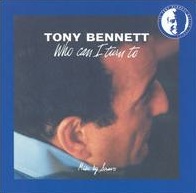Who Can I Turn To is a 1964 studio album by Tony Bennett.[3]
| Who Can I Turn To | ||||
|---|---|---|---|---|
 1964 LP | ||||
| Studio album by | ||||
| Released | November 16, 1964[1] | |||
| Recorded | August 14, 1964 (#1, 6), September 4, 1964 (#7–8, 11–12) September 29, 1964 (#2, 5, 10) October 14, 1964 (#3–4, 9) | |||
| Studio | CBS 30th Street (New York City) | |||
| Genre | Jazz | |||
| Length | 37:02 | |||
| Label | Columbia CL 2285 CS 9085 | |||
| Producer | Ernie Altschuler | |||
| Tony Bennett chronology | ||||
| ||||
| Alternative cover | ||||
 CD reissue | ||||
| Review scores | |
|---|---|
| Source | Rating |
| Allmusic | |
The album debuted on the Billboard Top LPs chart in the issue dated December 19, of that year, and remained on the album chart for 19 weeks, peaking at No. 42,[4] it also debuted on the Cashbox albums chart in the issue dated December 19, of that year, and remained on the chart for in a total of 20 weeks, peaking at 28[5]
Sony Music Distribution included this CD in a box set entitled The Complete Collection, which contains fifty-eight of his studio albums, 4 compilation, three DVDs, six volumes of Bennett’s non-album singles, a previously unreleased CD of his Las Vegas debut from 1964, and two discs of rarities, including Bennett’s first recording, an Army V-Disc of “St. James Infirmary Blues, and was released on November 8, 2011.[6]
Track listing
edit- "Who Can I Turn To?" (Leslie Bricusse, Anthony Newley) – 2:57
- "Wrap Your Troubles in Dreams (and Dream Your Troubles Away)" (Harry Barris, Ted Koehler, Billy Moll) – 3:12
- "There's a Lull in My Life" (Mack Gordon, Harry Revel) – 3:06
- "Autumn Leaves" (Joseph Kosma, Johnny Mercer, Jacques Prévert) – 2:00
- "I Walk a Little Faster" (Cy Coleman, Carolyn Leigh) – 4:23
- "The Brightest Smile in Town" (Ray Charles, Barry De Vorzon, Robert B. Sherman) – 2:56
- "I've Never Seen" (Dorcas Cochran, Don Marcotte) – 3:10
- "Between the Devil and the Deep Blue Sea" (Harold Arlen, Ted Koehler) – 3:15
- "Listen, Little Girl" (Fran Landesman, Tommy Wolf) – 2:22
- "Got the Gate on the Golden Gate" (Mel Tormé) – 3:05
- "Waltz for Debby" (Bill Evans, Gene Lees) – 3:36
- "The Best Thing To Be Is a Person" (Alan Brandt, Bob Haymes) – 3:00
Personnel
edit- Tony Bennett – vocals
- Sonny Russo, Bill Byers, Bill Elton, Bart Varsalona – trombones
- Earl Chapin, James Buffington, Richard Berg, Arty DeRosa, Ralph Froelich, Brooks Tillotson – French horn
- Romeo Penque, Ray Beckenstein, Leon Cohen, Irving Horowitz – woodwinds
- Ralph Sharon – piano
- Mundell Lowe, Al Caiola, Wally Richardson – guitar
- Hal Gaylord – bass
- Billy Exiner – drums
- Teddy Sommer – percussion
- George Siravo – arranger, conductor
Strings
edit- David Mankovitz, Al Brown, Calman Fleisig, Harold Furmansky – viola
- Tosha Samaroff, George Ockner, Aaron Rosand, Julius Schacter, Paul Gershman, Sol Shapiro, Carmel Malin, Gene Orloff, Peter Dimitriades, Harry Lookofsky, Joe Malin, Max Pollikoff, Harry Urbont, Manny Green, Harry Katzman, Arthur Bogin, Leo Kahn, Leo Kruczek, Arnold Eidus – violin
- Charles McCracken, George Ricci, George Koutzen, Peter Makas, Avron Twerdosky, Maurice Brown, Tony Sophos – cello
References
edit- ^ Tony Bennett.com
- ^ Allmusic review
- ^ Who Can I Turn To? at AllMusic
- ^ Whitburn, Joel (1996). Joel Whitburn's top pop albums : 1955-1996 : compiled from Billboard magazine's pop album charts, 1955-1996. Menomonee Falls, Wis.: Record Research. p. 74. ISBN 978-0-8982-0117-8.
- ^ Hoffmann, Frank W (1988). The Cash box album charts, 1955-1974. Metuchen, N.J.: Scarecrow Press. p. 28. ISBN 0-8108-2005-6.
- ^ "The Complete Collection - Tony Bennett". allmusic.com. Retrieved 8 October 2024.